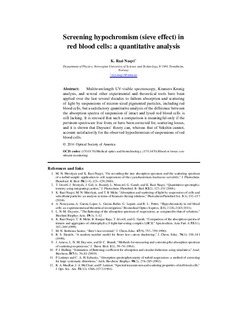| dc.contributor.author | Naqvi, Kalbe Razi | |
| dc.date.accessioned | 2016-06-09T09:15:15Z | |
| dc.date.accessioned | 2016-06-10T11:32:03Z | |
| dc.date.available | 2016-06-09T09:15:15Z | |
| dc.date.available | 2016-06-10T11:32:03Z | |
| dc.date.issued | 2014 | |
| dc.identifier.citation | Biomedical Optics Express 2014, 5(4):1290-1295 | nb_NO |
| dc.identifier.issn | 2156-7085 | |
| dc.identifier.uri | http://hdl.handle.net/11250/2392243 | |
| dc.description.abstract | Multiwavelength UV-visible spectroscopy, Kramers-Kronig analysis, and several other experimental and theoretical tools have been applied over the last several decades to fathom absorption and scattering of light by suspensions of micron-sized pigmented particles, including red blood cells, but a satisfactory quantitative analysis of the difference between the absorption spectra of suspension of intact and lysed red blood cells is still lacking. It is stressed that such a comparison is meaningful only if the pertinent spectra are free from, or have been corrected for, scattering losses, and it is shown that Duysens’ theory can, whereas that of Vekshin cannot, account satisfactorily for the observed hypochromism of suspensions of red blood cells. | nb_NO |
| dc.language.iso | eng | nb_NO |
| dc.publisher | Optical Society of America | nb_NO |
| dc.relation.uri | http://dx.doi.org/10.1364/BOE.5.001290 | |
| dc.title | Screening hypochromism (sieve effect) in red blood cells: a quantitative analysis | nb_NO |
| dc.type | Journal article | nb_NO |
| dc.type | Peer reviewed | nb_NO |
| dc.date.updated | 2016-06-09T09:15:15Z | |
| dc.source.pagenumber | 1290-1295 | nb_NO |
| dc.source.volume | 5 | nb_NO |
| dc.source.journal | Biomedical Optics Express | nb_NO |
| dc.source.issue | 4 | nb_NO |
| dc.identifier.doi | 10.1364/BOE.5.001290 | |
| dc.identifier.cristin | 1127368 | |
| dc.description.localcode | © 2014 Optical Society of America. This is the authors’ accepted and refereed manuscript to the article. | nb_NO |
